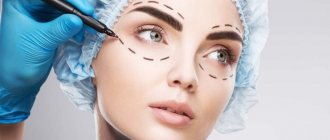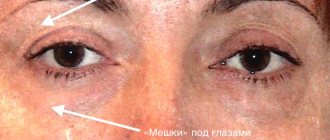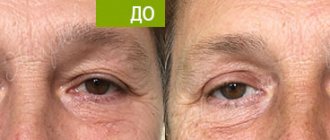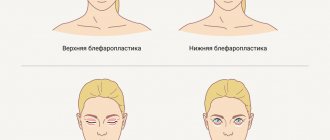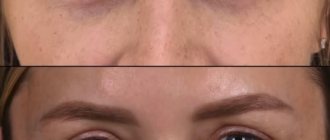Blepharoplasty (eyelid surgery) is an operation aimed at improving the shape, strengthening the muscle tone of the eyelid and eliminating aesthetic imperfections. Blepharoplasty is relevant for women and men over 35-40 years old. At this age, lifestyle changes or the use of cosmetics do not hide age-related changes, bags and dark circles under the eyes, wrinkles, and eyelid ptosis. It is also performed if there are indications (anatomical defects, desire to change the shape of the eyes) after 18 years.
Blepharoplasty is a surgical procedure during which excess eyelid skin is removed, subcutaneous fat tissue is redistributed, hernias are repaired, and the upper muscles around the eyes are tightened.
Types of operations:
- plastic surgery of the upper eyelids (performed through an incision in the natural fold);
- blepharoplasty of the lower eyelids (surgical access is located below the eyelash line);
- transconjunctival blepharoplasty (an incision is made on the inside of the eyelid, this option is suitable for young people with good skin elasticity);
- circular lift (the lower and upper eyelids are corrected at the same time);
- canthopexy and canthoplasty (the outer corner of the eye is raised, which eliminates the “tired” look, the shape of the eyes changes);
- plastic surgery of Asian eyelids (to give a “European” appearance).
Aesthetic ophthalmic surgery (blepharoplasty)
Aesthetic
ophthalmic surgery
– ophthalmological operations performed for cosmetic or functional-cosmetic purposes:
- on extraocular muscles (strabismus in adults)
- on the cornea (corneal clouding – eyesore)
- on the iris (post-traumatic or congenital defects, aniridia)
- on the lens (clouding – “white” pupil)
- on the eyelids
(violation of position, age-related changes in the skin of the eyelids) –
blepharoplasty
Blepharoplasty is a planned minimally invasive surgical operation to correct the upper and/or lower eyelids, during which excess eyelid skin is excised and intraorbital fatty hernias are removed or redistributed.
The operation is performed on an outpatient basis, under local infiltration anesthesia or using intravenous potentiation.
Indications for blepharoplasty are congenital and acquired ptosis, blepharochalasis, entropion and eversion of the eyelids.
But most often, blepharoplasty is performed solely for cosmetic (aesthetic) purposes. In aesthetic ophthalmology, the operation is aimed at eliminating senile (age-related) changes in the skin of the eyelids, removing excess fatty tissue (“bags” under the eyes).
Blepharoplasty as a treatment method
The absolute indication for such an operation today remains blepharochalasis - hypertrophy of the skin of the upper eyelid, in which, unlike ptosis, the edge of the eyelid is in the correct position. Externally, the disease manifests itself as thinning of the skin and the formation of a pathological fold hanging over the eye with noticeably visible blood vessels.
Blepharoplasty is the only way to restore the normal state of the upper eyelid. Surgical intervention is performed to excise a flap of skin; the measures of the subsequent rehabilitation period are aimed at speedy healing of the incision. The duration of blepharoplasty for both eyelids is 1-2 hours; the patient returns to his usual lifestyle after 10-12 days.
Blepharoplasty in aesthetic ophthalmology
Eyelid correction can be performed not only for medical reasons, but also at the request of the patient. In this way, sagging skin and fatty hernias are eliminated.
Depending on the purpose of the operation, the following is prescribed:
- upper eyelid blepharoplasty to remove sagging skin;
- blepharoplasty of the lower eyelids to remove or redistribute intraorbital fat (elimination of “bags”), correction of age-related skin changes;
- transconjunctival blepharoplasty of the lower eyelids, in which the incision is made from the inside of the eyelid.
Procedure for blepharoplasty
During the initial consultation, a medical history is collected - information about the patient’s chronic and past diseases, allergic reactions to sedatives and other medications, and current courses of treatment for other diseases. This is necessary to identify possible contraindications and determine the method of anesthesia. Since the operation is elective, it may be postponed until the time most appropriate for the patient's health.
Next is assigned:
- general blood and urine analysis; blood chemistry; tests for RW, Hbs antigen and HIV;
- fluorography;
- examination by a therapist, anesthesiologist and cardiologist (if necessary).
Based on the research results, the treatment plan can be adjusted. If no contraindications or diseases requiring preliminary treatment are identified, the patient is given recommendations on how to prepare for surgery. Two weeks before blepharoplasty, you must avoid using tobacco, alcohol, and medications containing aspirin. Also, preparation activities can be assigned individually.
Operational process
Blepharoplasty is performed by a board-certified plastic surgeon.
A distinctive feature of cosmetic eyelid surgery performed by a plastic ophthalmic surgeon-specialist ophthalmologist is the operation performed under an operating microscope, the use of the finest delicate instruments and suture material. The result of this surgery is the most natural appearance of the eyelid skin.
The order and type of manipulation depends on the chosen correction method:
- On the upper eyelid, an incision is made in a natural fold, excess skin is excised, and the finest sutures are placed on the incision;
- on the lower eyelid , an incision is made under the eyelashes, the skin is excised, intraorbital fat is removed or redistributed, sutures are applied with the same materials;
- In transconjunctival surgery, the incision is made on the inside of the lower eyelid.
Blepharoplasty is performed under local anesthesia or with intravenous administration of drugs that enhance the effect of painkillers.
Rehabilitation
A hospital stay after blepharoplasty is not required; if necessary or if the patient wishes, he can stay in the hospital for 1 day. Sutures are removed 5-7 days after surgery.
Depending on the type of operation, the final result of the correction appears after 2-4 months, the effect lasts on average from 5 to 10 years.
Operations for aesthetic indications at the Interroad Center of Ophthalmology are performed by an ophthalmic surgeon who has been trained in blepharoplasty in clinical residency, as well as in a thematic advanced course in plastic ophthalmic surgery at the Research Institute of Eye Diseases named after. Hemholtz in Moscow.
The fundamental differences between cosmetic blepharoplasty performed in an ophthalmology center and operations performed in the vast majority of plastic surgery clinics are:
- operations are performed by a microsurgeon under an ophthalmic surgical microscope
- The finest microsurgical instruments and threads are used, which helps ensure maximum delicacy of the operation, fastest healing and the best final aesthetic result
Preparing for blepharoplasty
During the consultation, the doctor examines the patient’s face, determines the skin tone, the nature of the defect and options for its elimination. To exclude health problems that may become an obstacle to blepharoplasty, you must undergo an examination:
- examination by an ophthalmologist (to check visual acuity, exclude conjunctivitis, blepharitis, glaucoma, dry eye syndrome);
- tests (urine, blood, including biochemistry, infections, coagulation, group and Rh factor);
- do an ECG, FOCG;
- obtain a physician’s opinion and consultation with an anesthesiologist.
At the VIP Academy Diagnostics and Treatment Center in Nizhny Novgorod, you can undergo all examinations before blepharoplasty.
2-3 weeks before eyelid surgery, you must stop taking anticoagulants, do not drink alcohol, and do not smoke. You should avoid visiting the solarium and do not sunbathe on the beach.
How is the operation performed?
The last meal is no later than 8 hours before surgery. You should not drink on the day of the intervention.
- Anesthesia is administered. The doctor makes an incision on the eyelid according to the markings made with a marker.
- The skin of the eyelid is separated from the muscle fibers and fat layer. Excess fat (hernia) is removed and its remains are redistributed. When the eyebrow line is lowered, not only the upper eyelid is lifted, but also the muscles surrounding the eye.
- Sutures are placed in the natural skin folds of the upper and lower eyelids (or on the outside), so after healing the scars become invisible. Bandages are applied over the stitches.
The operation takes 1-1.5 hours. After recovery from anesthesia, the patient can go home.
Circular plastic
Often, plastic surgery of the upper and lower eyelids is performed simultaneously. It is the type of plastic surgery that is most difficult to recover from, so patients need close medical supervision. Circular blepharoplasty is often performed to correct congenital defects or to change the shape of the eyes.
Preparing for blepharoplasty
As a result of the operation, no scars are formed. After agreeing on the operation with the surgeon, the patient will have to undergo tests to identify possible contraindications and minimize possible risks. During the consultation, the doctor can photograph the client’s eyes and also analyze their condition. He is obliged to give advice for proper preparation for the operation. The patient will be prohibited from taking certain medications, drinking alcohol, and smoking.
Works of a plastic surgeon - Sokolova M.A.
Recovery period after blepharoplasty
- Before the stitches are removed (after 4-7 days), it is forbidden to touch or rub the skin of the eyelids. Contact lenses must not be used. Hygienic care must be very delicate.
- After the operation, you should refrain from reading, working on a PC, or watching TV. For 2 weeks after blepharoplasty, it is recommended to wear sunglasses, do not drink alcohol, do not smoke, do not sunbathe, and do not wear makeup.
- You can return to your normal rhythm of life in 7-10 days. Physical activity is allowed to be resumed after 3 weeks.
- The results of blepharoplasty can be assessed after 1-1.5 months. They persist for the next 7-10 years.
Sign up for a consultation with a plastic surgeon at the VIP Academy Center for Diagnostics and Treatment to clarify prices and nuances of the operation.
Laser blepharoplasty of the lower eyelids
My tendency is to remove lower eyelid hernias using a transconjunctival incision and retroseptal dissection, which minimizes the potential complications caused by the open technique, such as postoperative lower eyelid ectropion, strip of sclera, and often a visible scar. .
In addition, when performing a transconjunctival approach, the rounding of the eye, which sometimes occurs after an external incision in the skin of the lower eyelid, is avoided.
In addition, patients are pleased if in the postoperative period there is only one scar that is not visible at all.
The problem of sagging skin of the lower eyelid is adequately solved using two simple maneuvers:
- performing laser resurfacing of the skin of the periorbital area
- "pinch" skin resection
Transconjunctival laser blepharoplasty via a retroseptal approach increased patient satisfaction and excessively reduced potential complications after lower blepharoplasty.
Therefore, the main and most important innovation between the past and the present in the field of blepharoplasty is the introduction of the transconjunctival approach and the use of laser for this procedure. Additionally, the addition of the two previously mentioned maneuvers makes the transconjunctival approach more popular and effective.
In cases where an open technique is required, such as in patients with excessive laxity of the skin of the lower eyelid and other severe signs of aging, the laser again plays an active role in the procedure.
The laser creates a very effective and longer-lasting contraction of the eyelid skin, which improves the final result.
The price of laser blepharoplasty is no different from scalpel blepharoplasty.
